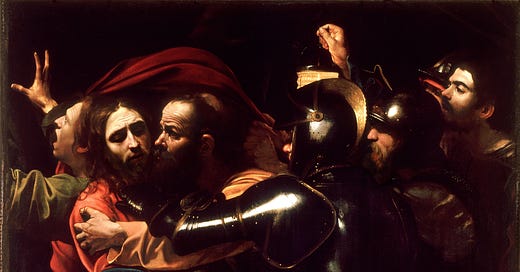I recently undertook to create an imitation of Caravaggio’s The Taking of Christ (shown above), which depicts Judas’ betrayal. Overall, my mid-range skill and the Master’s old vision combine to create something I like looking at, but one thing remains in his image that I absolutely cannot replicate: the astounding expression of Jesus’ face. As uncomfortable as it is for a self-respecting man to assume a posture of surrender, there is nothing impotent in that face. In the features of an Italian model on a canvas, Caravaggio transcribed the face of God – full of love and sadness.
It is a beautifully Christian painting, yet it was painted by a murderer. Italian courts sentenced the drunkard and ruffian Caravaggio to exile after he infamously killed a man over a soured tennis match. His excellence in his craft earned him commissions for the Roman church, but regardless of his inner spiritual life, we know that his work manifests the church far better than the man. Technical excellence is mercenary: like physical beauty, it may not discriminate but does differentiate; it can’t be bought but it will lend to the highest bidder.
The church has long evangelized the world through art. Stations of the cross served as Gospel-teaching tools to the illiterate in Gothic cathedrals and Christian rock band Stryper used “To Hell with the Devil” to minister to 80’s-era stoners. However, in contrast to the mercenary art promulgated in the old church, 21st century religious art emphasizes Christianity as an identity that the artist shares with the world. We 21st century Christians are strangely concerned with the sources of our goods and services: were our founders slave-owners? Is our coffee ethically sourced? Is John Mayer a good guy? I am far more likely to hear talk of a Christian artist than of a Christian work of art. Some churchgoing people know the name Makoto Fujimura, but few of them can name any of his paintings.
The result of this shift has been a barrage of mediocre religious art in both Protestant and Romanist circles. If art is about artists, then the art can suffer while the artist rises to some lofty pedestal. This is a direct inheritance from the secular enterprise, beginning in rationalism, stepping through humanism and into existentialism. Whereas art used to be a vehicle for transcendent experience and the expression of beauty and truth, the pedophiles who threw out transcendent reality could only use it for the expression of subjective experiences: in short, the exposure of the artist’s dilapidated self-concept.
Christian institutions betray their unconscious allegiances to these ideas when they promote Christian artists or even Christian entertainment as valuable merely by virtue of their Christian identification. The orthodox Christian holds that in the work, beauty and craft are the real goods, insofar as they reflect the general character of God. It is believed that Christians lost the culture war: our strategy was quantity over quality, and if it could be won on those terms, we would still be a nominally Christian nation. We secularly-influenced Christians thought instead that culture was whatever was fashionable and comfortable, and that we needed to make a Christian branded version of as much of that thing as possible. We needed as many Christian rock bands as we could vomit out.
Genuine culture is produced by the outliers who are utterly unconcerned with culture. These outliers generally aren’t the “Portrait of an Artist as a Young Man,” the passion-seekers or the believers. They are illegible people who care about technical achievement and need money. They move the cultural compass significantly, as the artistic record bears out, inventing new methods and imagining new experiences. Picasso, that archetypical painter, was a master of the technical methods of the tradition before he chose to pursue new ways of seeing. His patrons were more interested in his vision than in his person, and his influence has arguably touched everyone in the West, including those who dislike his work or his person. Such was Caravaggio. Are we willing to attend to these men’s visions and pay the price for their time?




How do you think art viewers/listeners can help change their habits to encourage a shift in a better direction?